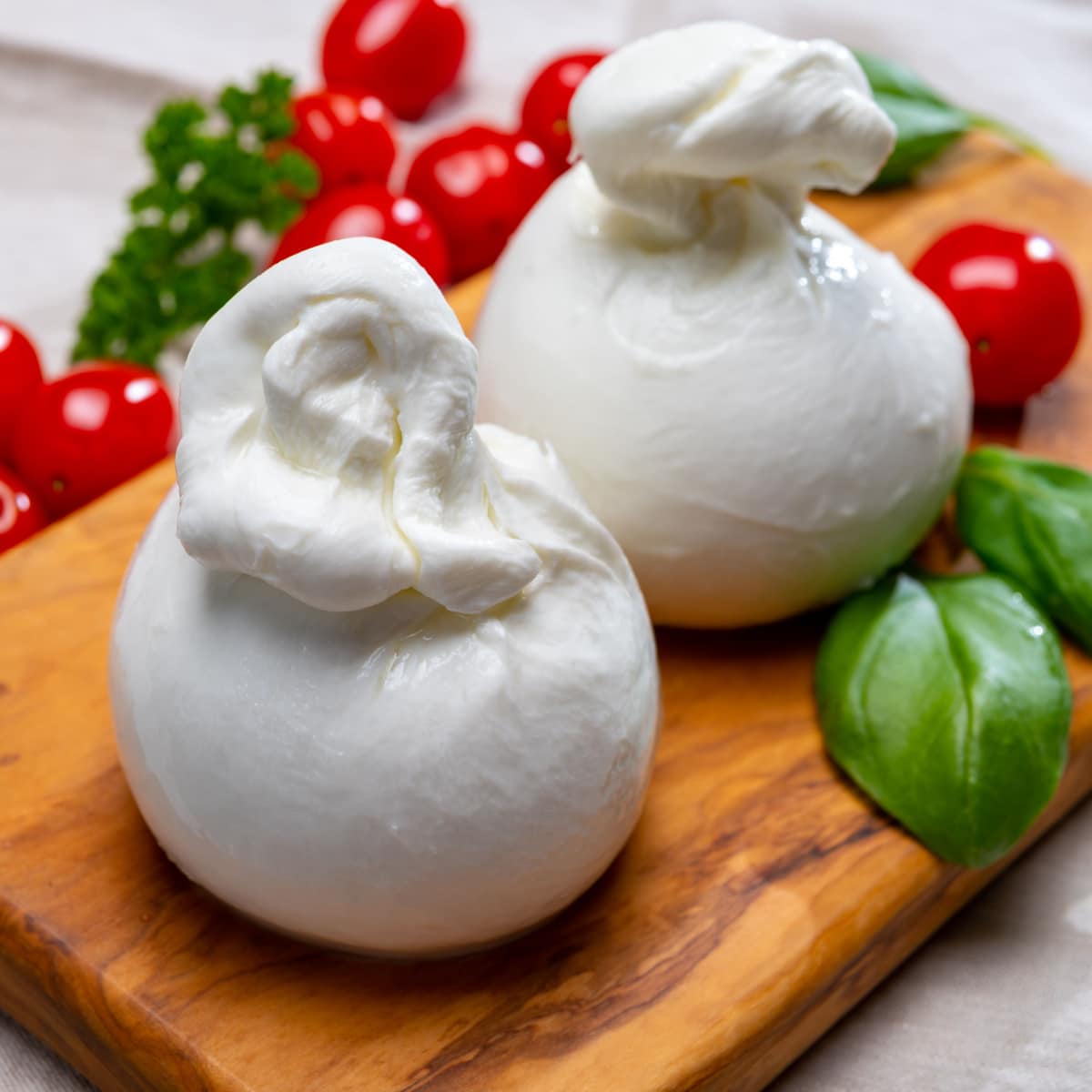Burrata cheese is a decadent Italian dairy delight that takes mozzarella to a whole new level. A delicate pouch of soft, stretchy curd holds a scrumptious mix of cream and curd fragments. The result is a creamy, buttery explosion that oozes luxury with every bite.
Creamy, fresh, and decadent, it’s like a slice of heaven!

In the vast world of cheese, burrata stands out as one of a kind. The unique texture and rich flavor are unmatched by any other type.
But what is burrata, exactly? And why all the fuss?
Learn the answers to these questions and more. From taste to substitutions, you’ll soon discover what makes this Italian delicacy so special.
What Is Burrata Cheese?
Imagine cutting into mozzarella to reveal a creamy, buttery interior. What you’re envisioning is burrata.
A staple in Italian cuisine, this fresh cheese comes from the Apulia region. It was created in the 1950s as a solution for using up mozzarella scraps.
Despite how long it’s been around, burrata didn’t become popular in America until recently. And we couldn’t be more excited about it!
The texture and the flavor are exquisite. The firm exterior is a casing of mozzarella. Slice through the shell and you find an oozing center made from cheese curds and cream.
It’s oh-so-creamy and rich. In fact, “borro” means “buttered” in Italian, reflecting its decadence.
The contrast in texture along with the flavor makes burrata a favorite among cheese lovers. So it’s not surprising it’s become very popular.

How Is Burrata Cheese Made?
Burrata is a type of fresh cheese made from cow’s milk. Sometimes, you come across versions made with buffalo milk.
Crafting this Italian delight is a true art form. It begins by adding rennet and cultures to warm milk, causing it to curdle. The curds are then put into hot water or whey to make them pliable.
From there, they’re stretched and weaved to create a spun consistency. Then, it’s molded into a pouch.
Here’s where things get really interesting. The pouch gets stuffed with curds and cream, and then sealed.
And there you have it, super fresh burrata!
What Does Burrata Taste Like?
In a word, it tastes divine. Burrata is about as decadent as fresh cheese gets. The flavor is super creamy and buttery like mozzarella. But it’s even more milky and rich.
The texture is just as lavish. On the outside, there’s a firmer layer of mozzarella. Inside the casing is a gooey center of creaminess.
For a cheese lover, burrata is pure bliss. It just melts in your mouth!
Burrata vs. Mozzarella (What’s the Difference?)
By looks alone, these two cheeses are hard to tell apart. Burrata and mozzarella look practically identical and even taste similar.
To make matters more confusing, burrata is part mozzarella. But despite their similarities, they’re two distinct cheeses. The main difference is how they’re made.
From the inside to the outside, mozzarella is all cheese curds. But burrata has a creamy surprise. The outer layer is made from mozzarella. Hiding inside is a fresh cream and cheese curds center.
The taste is also different. Both are creamy, but burrata is more buttery and rich.

How to Eat Burrata
The best way to eat burrata is fresh and at room temperature. Serving it this way highlights its luxurious gooey center and creamy flavor.
Drizzle a little extra olive oil on top and smear it on crostini. Add a slice or two of heirloom tomatoes while you’re at it.
Burrata is versatile enough for pizzas, salads, soups, pasta, charcuterie boards, risotto, and more.
I enjoy marinating it and serving it like a spread. It’s an exquisite addition to bruschetta and at home in a caprese.
The creaminess pairs wonderfully with salty prosciutto and sweet peaches in a salad. And I just love the contrast of flavors when adding balsamic roasted tomatoes.
Whatever you add it to, burrata makes any dish more extraordinary.
How to Store
When it comes to burrata, the fresher the better! This Italian cheese is best when enjoyed within hours of it being made.
But not all of us have the luxury of buying it directly from the source. Therefore, keep store-bought burrata in the refrigerator.
Be sure to place it in water and seal it in an air-tight container. Once it’s opened, consume burrata within 5 days.
I don’t recommend freezing burrata because it has a high water content. It changes the texture, causing the cheese to lose most of its signature fresh appeal.

Substitutes for Burrata
If you can’t get your hands on burrata, mozzarella is as close as it gets. After all, mozzarella is part of its ingredients!
Bocconi is a type of young mozzarella, making it a good replacement. Use it for things like salads or cheese boards.
Keep in mind, these types of cheese don’t have the same creamy filling. When serving them fresh, you’re missing out on that unique creamy center.
However, melting the cheese is another story. When you heat burrata, the gooey center loses its beloved structure.
Mozzarella is the better choice here. The taste is similar, it melts well, and it’s yummy on just about everything.










